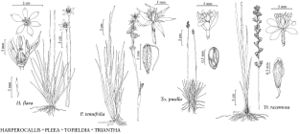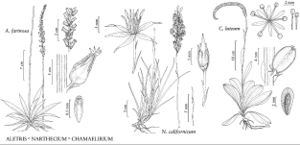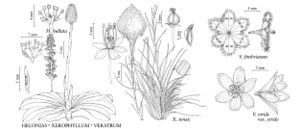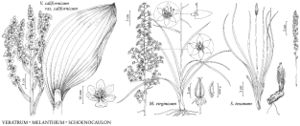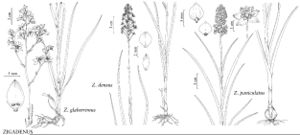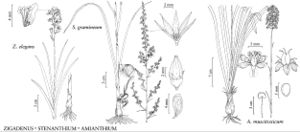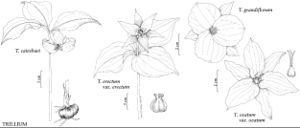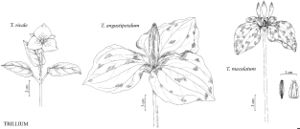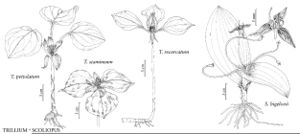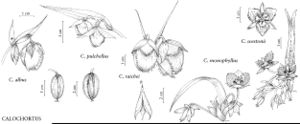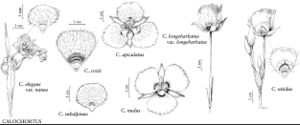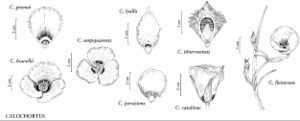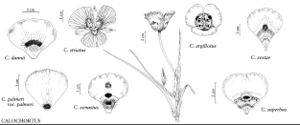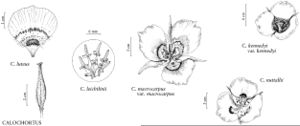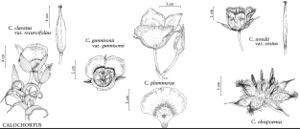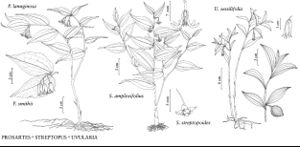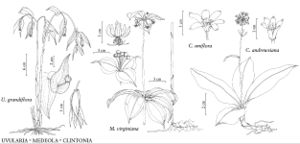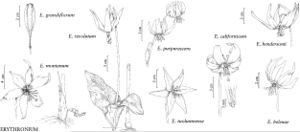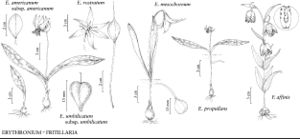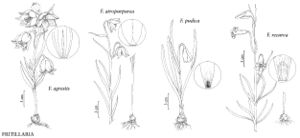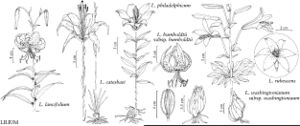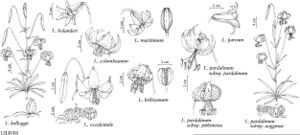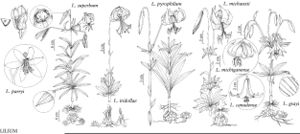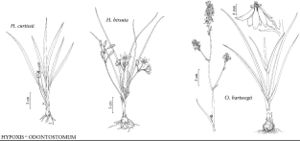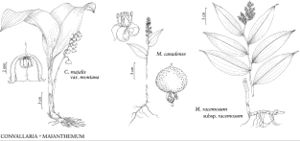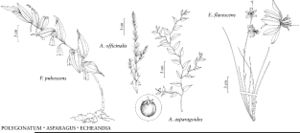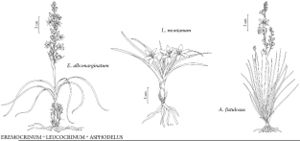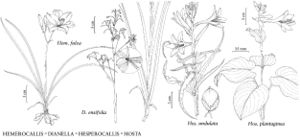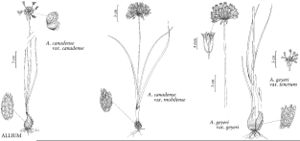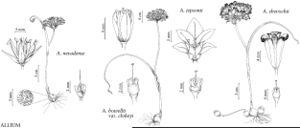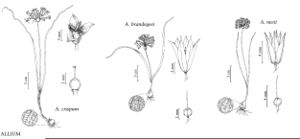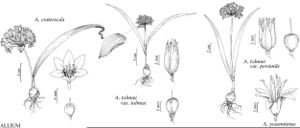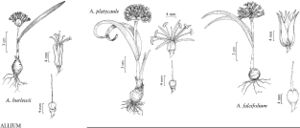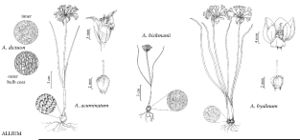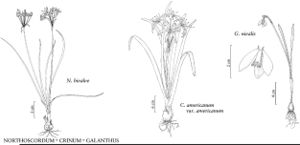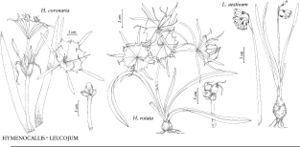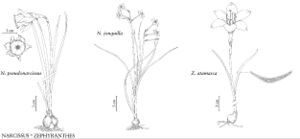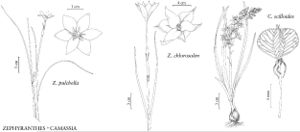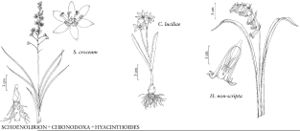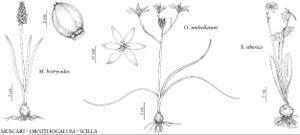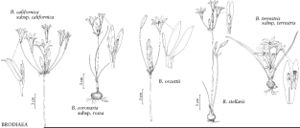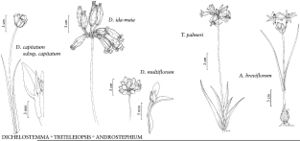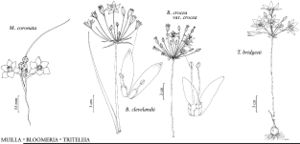Liliaceae
Herbs or shrubs, sometimes vines in Asparagus, perennial, mostly geophytic, scapose or caulescent, sometimes woody, from elongate, sometimes tuberous rhizomes, or from scaly or tunicate bulbs, or from solid corms. Leaves only rarely persistent, simple, basal and/or cauline, alternate, opposite, or whorled, herbaceous (scalelike in Asparagus), sometimes sheathing; blade typically narrow and parallel-veined, occasionally broad and/or reticulate-veined. Inflorescences racemose, spicate, paniculate, cymose, umbellate, or with flowers single or paired in leaf-axils; bracts 1–several, sometimes involucrate or sheathing, or bracts absent. Flowers usually bisexual, sometimes bisexual and unisexual, or unisexual only, usually pedicellate, occasionally sessile; perianth actinomorphic or zygomorphic, often very showy; tepals 6, distinct or less often connate proximally forming tube that may also bear a corona, usually petaloid and ± equal in 2 whorls of 3, or those of outer whorl narrower, greener, more sepaloid; tepal nectaries often present; stamens 6, rarely 3 or 4, sometimes 3 fertile and 3 staminodial, free or adnate to perianth; filaments slender to dilated, occasionally connate-coroniform and/or with bases dilated to form wings; anthers basifixed with latrorse dehiscence or dorsifixed, versatile, and with introse or extrorse dehiscence, cordate to linear; ovary superior to inferior, (2–) 3 (–4) -locular, often with septal nectaries, ovules usually several or many per locule; styles 1 or 3 (–4); stigmas several and distinct or 1 and capitate. Fruits capsular and loculicidal or septicidal, membranaceous to leathery, or baccate, or dry and indehiscent. Seeds 1–many, often flat and wind-distributed, sometimes thicker and with fleshy elaiosomes. x = 3–27+.
Contents
Distribution
Nearly worldwide, primarily tropical regions, widely cultivated
Discussion
Genera ca. 280, species ca. 4200 (70 genera, 478 species in the flora; 16 genera, 54 species introduced).
There is no question that the evidence available today (Angiosperm Phylogeny Group 1998; P. J. Rudall et al. 1995; K. L. Wilson and D. A. Morrison 2000) strongly supports extensive dismemberment of A. Cronquist’s (1981, 1988, 1993) very broadly circumscribed Liliaceae. No fewer than 30 segregate families have been recognized, though there is not universal acceptance of all of them, and in some cases their ordinal associations are not yet settled. For the genera of Cronquist’s Liliaceae that are present in the flora, Table 1 summarizes their dispositions among the maximum number of segregate families in recent use. Whether ranked as families or otherwise, these sets of genera represent identifiable lineages that have been variously grouped in recent classifications of the monocots (A. L. Takhtajan 1997; K. Kubitzki et al. 1990+, vol. 3; W. S. Judd et al. 1999; R. F. Thorne 2000; A. B. Doweld 2001). Comments on these assemblages appear below, as well as within the various generic discussions and in the introductory chapter on monocot classification by J. L. Reveal and J. C. Pires at the front of this volume.
Traditionally, Pleea, Triantha, Isidrogalvia Ruíz & Pavón (5 species, South America), Tofieldia, and Harperocallis have been included in the tribe Tofieldieae Horaninow within a polyphyletic Melanthiaceae or Liliaceae sensu lato. However, the vastly different morphologies, anatomies, and cytologies of this lineage (J. D. Ambrose 1975, 1980; M. Takahashi and S. Kawano 1989; R. W. Cruden 1991; P. Goldblatt 1995; M. N. Tamura 1995, 1998b; W. B. Zomlefer 1997c) support its recognition as a separate family, Tofieldiaceae (A. L. Takhtajan 1994b, 1997), in a monotypic order, Tofieldiales (J. L. Reveal and W. B. Zomlefer 1998).
The segregate family Nartheciaceae includes three genera that are present in the flora: Aletris, Narthecium, and Lophiola Ker Gawler (treated under Haemodoraceae herein see p. 47).
Many botanists now consider Trillium and the closely related genera Daiswa Rafinesque, Paris Linnaeus, Kinugasa Tatenaki ex Suto, and Trillidium Kunth (when recognized separately) to constitute the separate family Trilliaceae (R. Y. Berg 1962b; S. Kazempour Osaloo, F. H. Utech, M. Ohara and S. Kawano 1999; S. Kazempour Osaloo and S. Kawano 1999; W. B. Zomlefer 1996). Others (M. W. Chase et al. 2000; W. B. Zomlefer et al. 2001) have defined the Melanthiaceae to include these genera, though the two groups have markedly different morphologies and karyologies.
Most recently, Uvularia has been associated not as before with the Melanthiaceae (J. D. Ambrose 1975, 1980; W. B. Zomlefer 1997b) or the Uvulariaceae of R. M. T. Dahlgren et al. (1985) or the Convallariaceae of A. L. Takhtajan (1980, 1997), but with the east Asian Disporum Salisbury in an expanded Colchicaceae (B. Nordenstam 1998; K. Hayashi et al. 1998).
As defined by A. Cronquist (1981), the Liliaceae contained “about 280 genera and nearly 4000 species.” In a much more restricted, recent sense, the family was considered to include just 11 genera and perhaps 545 species (R. F. Thorne 2000). Thorne recognized two subfamilies, of which the Medeoloideae (Medeola and Clintonia) have sometimes been segregated as the Medeolaceae (A. L. Takhtajan 1997; A. B. Doweld 2001).
T. B. Patterson (1998), K. Kubitzki et al. (1990+, vol. 3), W. S. Judd et al. (1999), R. F. Thorne (2000), and T. B. Patterson and T. J. Givnish (1998) have recognized Calochortaceae separate from Liliaceae. As circumscribed by Patterson and Givnish, the family includes Calochortus, Prosartes, Scoliopus, Streptopus, and Tricyrtis Wallich (not in the flora). A. L. Takhtajan (1997) distributed these genera among three segregate families: Calochortaceae, Scoliopaceae, and Tricyrtidaceae.
Hesperocallis is currently treated as the sole representative of the segregate family Hesperocallidaceae (H. P. Traub 1972; A. L. Takhtajan 1997). Karyologically and embryologically, Hesperocallis is nearest to Hosta (Hostaceae) and the Agavaceae (M. S. Cave 1948, 1970), and even though their base chromosome numbers are different [x = 24 in Hesperocallis and x = 30 in Hosta and Agavaceae (T. W. Whitaker 1934; D. Satô 1935; S. Sen 1975, F. Maekawa and K. Kaneko 1968; M. N. Tamura 1995)], they share a strongly bimodal karyotype. As well, the pollen grains of Hosta plantaginea and Hesperocallis have similar unibaculate muri (A. Alvarez and E. Köhler 1987). Hosta has long been associated with Hemerocallis and Leucocrinum in the liliaceous tribe Hemerocallideae. However, recent molecular and morphological evidence (M. W. Chase et al. 1996; P. J. Rudall and D. F. Cutler 1995) supports separating these genera—Hemerocallis in the Hemerocallidaceae, Leucocrinum in the Anthericaceae (J. G. Conran 1998), and Hosta in a monotypic Hostaceae (K. Kubitzki 1998b; A. L. Takhtajan 1997; W. B. Zomlefer 1998).
In the past, several taxonomic affinities have been suggested for Androstephium, Bloomeria, Brodiaea, Dichelostemma, Milla, Muilla, Triteleia, and Triteleiopsis (Liliaceae, Amaryllidaceae, Alliaceae), but most recently they have been placed in the resurrected family Themidaceae based on molecular and anatomical evidence (M. F. Fay and M. W. Chase 1996; J. C. Pires 2000; J. C. Pires et al. 2001).
The Liliaceae include numerous important ornamentals such as Amaryllis, Hemerocallis, Hosta, Lilium, Narcissus, and Tulipa. The family is a dominant component in the temperate spring flora, which includes both native and introduced species. Many of the introductions, or cultivars derived from them, are from ecologically equivalent, temperate zones and their naturalization potential is high. Asparagus and Allium have edible species of major economic importance, while numerous other genera (e.g., Convallaria, Ornithogalum, Veratrum, Zigadenus) are highly toxic due to the presence of various alkaloids and cardenolides (G. E. Burrows and R. J. Tyrl 2001).
Several horticultural exotics that have been reported as escaped in the flora (J. T. Kartesz and C. A. Meacham 1999) are not clearly naturalized and are not treated herein. They include: Colchicum autumnale Linnaeus, Gagea fistulosa Ker Gawler, G. villosa (M. Bieberstein) Duby, Gloriosa superba Linnaeus, Kniphofia uvaria (Linnaeus) Oken, Liriope muscari (Decaisne) L. H. Bailey, L. spicatum Loureiro, Lycoris radiata (L’Heritier) Herbert, L. squamigera Maximowicz, Ophiopogon jaburan (Siebold) Loddiges, Sternbergia lutea (Linnaeus) Ker Gawler ex Sprengel, and Tricyrtis hirta (Thunberg) Hooker.
Tables
Table 1. Statistics for Volume 26 of Flora of North America.
| Family | Total Genera | Total Species | Endemic Genera | Endemic Species | Introduced Genera | Introduced Species | Conservation Taxa |
|---|---|---|---|---|---|---|---|
| Pontederiaceae | 4 | 11 | 0 | 0 | 2 | 3 | 0 |
| Haemodoraceae | 2 | 2 | 1 | 1 | 0 | 0 | 0 |
| Liliaceae | 70 | 478 | 19 | 373 | 16 | 54 | 76 |
| Iridaceae | 16 | 92 | 0 | 61 | 9 | 19 | 10 |
| Aloaceae | 1 | 2 | 0 | 0 | 1 | 2 | 0 |
| Agavaceae | 9 | 84 | 0 | 38 | 2 | 6 | 10 |
| Stemonaceae | 1 | 1 | 0 | 1 | 0 | 0 | 0 |
| Smilacaceae | 1 | 20 | 0 | 16 | 0 | 0 | 1 |
| Dioscoreaceae | 1 | 6 | 0 | 2 | 0 | 4 | 0 |
| Burmanniaceae | 3 | 5 | 0 | 1 | 0 | 0 | 1 |
| Orchidaceae | 69a | 207b | 3 | 96 | 1 | 6 | 18 |
| Totals | 177a | 908b | 23 | 589 | 31 | 94 | 116 |
Italic = introduced
adoes not include Spathoglottis [see footnote on page 491]
bdoes not include Spathoglottis plicata [see footnote on page 491]
Selected References
None.
Lower Taxa
Illustrations
Key
| 1 | True leaves small, scalelike, their function taken over by lanceolate or ovate, filiform, or flattened cladophylls that are borne singly or in clusters in leaf axils. | Asparagus |
| 1 | True leaves (bracts in Trillium) present, herbaceous, cladophylls absent. | > 2 |
| 2 | Ovary subterranean. | Leucocrinum |
| 2 | Ovary above ground. | > 3 |
| 3 | Ovary inferior (or partly inferior in Zigadenus). | > 4 |
| 3 | Ovary superior (only partly superior in Aletris, Amianthium, Melanthium, Stenanthium, and Veratrum). | > 14 |
| 4 | Inflorescences racemose, corymbose, or paniculate. | Zigadenus |
| 4 | Inflorescences 1-flowered or umbellate. | > 5 |
| 5 | Flowers with corona. | > 6 |
| 5 | Flowers without corona. | > 8 |
| 6 | Corona funnelform or rotate. | Hymenocallis |
| 6 | Corona cupular to trumpetlike. | > 7 |
| 7 | Perianth yellow and/or white; corona tubular and separate from filaments; stigma 3-lobed. | Narcissus |
| 7 | Perianth reddish to salmon, each outer tepal with whitish adaxial midstripe; corona minute, reduced to small crown; stigma capitate or slightly 3-lobed. | Hippeastrum |
| 8 | Plants from tubers, rhizomes, or corms. | > 9 |
| 8 | Plants from bulbs. | > 10 |
| 9 | Rootstocks tuberous; plants with leafy stems; flowers slightly zygomorphic; tepals red, orange, purple, green or white, frequently spotted. | Alstroemeria |
| 9 | Rootstocks rhizomatous or cormlike; plants scapose, with short, subterranean stem; flowers actinomorphic; tepals often greenish abaxially, yellow adaxially, ± pilose. | Hypoxis |
| 10 | Inflorescences few- to many-flowered; style capitate; capsules prominently beaked. | Crinum |
| 10 | Inflorescences 1–7-flowered; style filiform or clavate; capsules globose or ± subglobose. | > 11 |
| 11 | Flowers declinate or ± erect; perianth 2–16 cm. | > 12 |
| 11 | Flowers nodding; perianth 2.5 cm or shorter. | > 13 |
| 12 | Stamens of two lengths. | Zephyranthes |
| 12 | Stamens of four lengths. | Habranthus |
| 13 | Inflorescences 2–7-flowered; scape hollow; tepals equal. | Leucojum |
| 13 | Inflorescences 1-flowered; scape solid; tepals unequal. | Galanthus |
| 14 | Inflorescences umbellate (or sometimes racemose in Dichelostemma), always subtended by spathes or bracts. | > 15 |
| 14 | Inflorescences various or 1-flowered, sometimes bracteate, never spathaceous. | > 24 |
| 15 | Tepals distinct or connate basally into very short perianth tube. | > 16 |
| 15 | Tepals distinctly connate proximally into perianth tube. | > 18 |
| 16 | Plants smelling of onion. | Allium |
| 16 | Plants not smelling of onion. | > 17 |
| 17 | Filaments sometimes dilated at base into cup, cup sometimes with basal filament appendages; pedicel articulate. | Bloomeria |
| 17 | Filaments sometimes overlapping or connate but without appendages; pedicel not articulate. | Muilla |
| 18 | Bracts 4; flowers sessile but appearing pedicellate because of long, slender perianth tube. | Milla |
| 18 | Bracts 2 or more; flowers pedicellate. | > 19 |
| 19 | Fertile stamens 3 (or 6 but 3 much smaller). | > 20 |
| 19 | Fertile stamens 6. | > 21 |
| 20 | Leaves rounded abaxially; scape rigid; inflorescences open; staminodia usually 3, alternating with 3 fertile stamens; corona absent; stigma 3-lobed, lobes distinctly spreading and recurved. | Brodiaea |
| 20 | Leaves keeled abaxially; scape curved to twining; inflorescences usually dense; perianth appendages arising from intersection of perianth tube and lobes, forming corona; stigma weakly 3-lobed. | Dichelostemma |
| 21 | Filaments connate into tube with 2-fid appendages forming crown. | Androstephium |
| 21 | Filaments distinct, or crown not formed by 2-fid lobes. | > 22 |
| 22 | Plants from bulbs with membranous outer coats. | Nothoscordum |
| 22 | Plants from fibrous-coated corms. | > 23 |
| 23 | Scape 1–5 mm diam.; stigma weakly 3-lobed. | Triteleia |
| 23 | Scape 7–15 mm diam.; stigma not lobed. | Triteleiopsis |
| 24 | Styles 3 (rarely 4), distinct, or stigmas 3, distinct (sometimes connate in Trillium), borne directly on ovary. | > 25 |
| 24 | Style 1, sometimes 3-branched or -lobed at apex, or absent and stigmas connate, borne directly on ovary. | > 40 |
| 25 | Leaves (bracts in Trillium) in 1 or 2 whorls on flowering stem, or 2, opposite, never long and grasslike. | > 26 |
| 25 | Leaves several to many, all basal or borne on flowering stem, if 2 and opposite then grasslike, at least 8 times longer than broad. | > 28 |
| 26 | Flowers solitary, terminal. | Trillium |
| 26 | Flowers in umbellate arrays. | > 27 |
| 27 | Leaves 2 at base of each flowering stem; stamens 3. | Scoliopus |
| 27 | Leaves in 2 whorls on each flowering stem; stamens 6. | Medeola |
| 28 | Some part of plant obviously hairy or covered with scales (except glabrous in Amianthium). | > 29 |
| 28 | No part of plant obviously hairy or covered with scales. | > 33 |
| 29 | Tepals conspicuously clawed. | Melanthium |
| 29 | Tepals not clawed. | > 30 |
| 30 | Leaf blades broadly ovate to elliptic with many conspicuous veins, narrowed towards stalklike, sheathing bases. | Veratrum |
| 30 | Leaf blades narrow, without conspicuous veins, not narrowing towards sheathing bases. | > 31 |
| 31 | Perigonal nectaries absent. | Amianthium |
| 31 | Perigonal nectaries not well developed to prominent. | > 32 |
| 32 | Seeds broadly winged. | Melanthium |
| 32 | Seeds irregularly compressed or angled. | Schoenocaulon |
| 33 | Plants from bulbs and reduced rhizomes. | Stenanthium |
| 33 | Plants from rhizomes or fleshy roots. | > 34 |
| 34 | Anther dehiscence extrorse; capsules loculicidal. | > 35 |
| 34 | Anther dehiscence introrse; capsules septicidal. | > 37 |
| 35 | Plants from rhizome terminating in bulb, roots thick and cordlike; leaves rigid, filiform; inflorescences bracteate. | Xerophyllum |
| 35 | Plants from rhizomes with fibrous roots; leaves flexible, broad; inflorescences ebracteate. | > 36 |
| 36 | Flowers dioecious, occasionally polygamodioecious; tepals white to greenish white, drying to yellow; gynoecium weakly syncarpous (carpels coherent); style arising from ovary apex; seeds with winglike arils. | Chamaelirium |
| 36 | Flowers bisexual only; tepals purplish pink; gynoecium syncarpous; style sunken into ovary apex; seeds caudate at both ends. | Helonias |
| 37 | Inflorescences 1-flowered; braceteoles of epicalyx distinct; anthers with appendages; ovary and fruits conspicuously and densely tuberculate; seeds yellowish. | Harperocallis |
| 37 | Inflorescences racemose or thyrsate; bracteoles of epicalyx connate; anthers without appendages; ovary and fruits glabrous or with minute, scattered tubercles; seeds reddish brown to brown. | > 38 |
| 38 | Anthers 9. | Pleea |
| 38 | Anthers 6. | > 39 |
| 39 | Stems smooth; seeds without appendages. | Tofieldia |
| 39 | Stems glandular-pubescent; seeds with appendages. | Triantha |
| 40 | Tepals connate basally for more than 1/10 total length. | > 41 |
| 40 | Tepals distinct or connate basally for less than 1/10 total length. | > 49 |
| 41 | Flowering stems leafy. | > 42 |
| 41 | Flowering stems leafless, leaves all or mostly basal. | > 43 |
| 42 | Leaves distinctly petiolate; racemes 1-sided. | Convallaria |
| 42 | Leaves clasping, subsessile, or short-petiolate; racemes not 1-sided. | Polygonatum |
| 43 | Plants from rhizomes with fleshy or fibrous roots. | > 44 |
| 43 | Plants from bulbs. | > 46 |
| 44 | Leaves distinctly petiolate. | Hosta |
| 44 | Leaves sessile. | > 45 |
| 45 | Inflorescences racemose; style 3-branched at apex. | Aletris |
| 45 | Inflorescences 1-flowered or in terminal helicoid cymes; style unbranched at apex. | Hemerocallis |
| 46 | Inflorescences dense, racemose. | Muscari |
| 46 | Inflorescences open, racemose or paniculate. | > 47 |
| 47 | Perianth 4.5–6 cm, funnelform. | Hesperocallis |
| 47 | Perianth 2 cm or shorter, lobes spreading or reflexed. | > 48 |
| 48 | Plants 10–20 cm; tepals blue or blue and white; anther dehiscence introrse. | Chionodoxa |
| 48 | Plants 12–55 cm; tepals creamy white to yellowish; anthers dehiscing through pores | Odontostomum |
| 49 | Plants from rhizomes with fleshy or fibrous roots (except from corms in Echeandia). | > 50 |
| 49 | Plants from bulbs or corms. | > 61 |
| 50 | Leaves basal. | > 51 |
| 50 | Leaves cauline (or basal in Dianella). | > 55 |
| 51 | Fruits baccate. | Clintonia |
| 51 | Fruits capsular. | > 52 |
| 52 | Stamens 3; tepals dimorphic. | Scoliopus |
| 52 | Stamens 6; tepals equal. | > 53 |
| 53 | Ovules 1 or 2 per locule. | Asphodelus |
| 53 | Ovules 4–8+ per locule. | > 54 |
| 54 | Anthers dorsifixed near base. | Echeandia |
| 54 | Anthers basifixed. | Eremocrinum |
| 55 | Fruits capsular. | > 56 |
| 55 | Fruits baccate. | > 57 |
| 56 | Inflorescences racemose; tepals spreading; filaments pubescent. | Narthecium |
| 56 | Inflorescences 1-flowered; tepals imbricate; filaments glabrous. | Uvularia |
| 57 | Anthers opening by pores. | Dianella |
| 57 | Anthers opening by slits. | > 58 |
| 58 | Flowering stem with only 2 or 3 leaves along its length or with several leaves concentrated towards base. | Maianthemum |
| 58 | Flowering stem leafy over most of its length below inflorescence. | > 59 |
| 59 | Flowers solitary or in pairs; peduncle adnate to stem, arising opposite next leaf axial, free portion of pedicel geniculate. | Streptopus |
| 59 | Flowers and pedicel not as above, peduncle absent. | > 60 |
| 60 | Stems simple; tepals neither swollen nor slightly inflated above base; ovary with septal nectaries. | Maianthemum |
| 60 | Stems branched distally; tepals weakly gibbous proximally; ovary lacking septal nectaries. | Prosartes |
| 61 | Plants caulescent or scapose; inflorescences usually racemose, never paniculate; perianth never blue (except in a few species of Calochortus). | > 62 |
| 61 | Plants scapose, never caulescent; inflorescences varying, sometimes paniculate; perianth often blue. | > 68 |
| 62 | Tepals without nectaries at base. | Tulipa |
| 62 | Tepals with nectaries at base. | > 63 |
| 63 | Style absent, stigmas borne directly on ovary. | Calochortus |
| 63 | Style present. | > 64 |
| 64 | Inflorescences racemose, umbellate, or paniculate. | > 65 |
| 64 | Inflorescences racemose only. | > 66 |
| 65 | Tepals twisting together after flowering; pedicel articulate. | Chlorogalum |
| 65 | Tepals not twisting together after flowering; pedicel not articulate. | Lilium |
| 66 | Tepals reflexed. | Erythronium |
| 66 | Tepals not reflexed, or reflexed only at apex. | > 67 |
| 67 | Tepals in 2 distinct whorls; bulb tunics usually absent, thin and white if present. | Fritillaria |
| 67 | Tepals not in 2 distinct whorls; bulb tunics always brown. | Lloydia |
| 68 | Perianth white, each tepal with wide green abaxial stripe. | Ornithogalum |
| 68 | Perianth variously colored. | > 69 |
| 69 | Ovules 2 per locule; tepals 3–12 mm. | > 70 |
| 69 | Ovules 1–12 per locule; tepals (6–)12–40 mm. | > 71 |
| 70 | Pedicel 6–15(–30) mm; filaments equal, 1–2 mm. | Schoenolirion |
| 70 | Pedicel 2–3 mm; filaments dimorphic, 4–8 mm. | Hastingsia |
| 71 | Tepals each 3–4-veined. | Camassia |
| 71 | Tepals each 1-veined. | > 72 |
| 72 | Bracts 2 per flower. | Hyacinthoides |
| 72 | Bracts 1 per flower, or absent. | Scilla |
